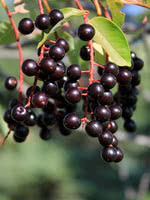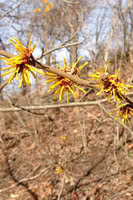Mon-Fri 9am - 5pm Mountain time
Western Chokecherry vs Witch Hazel
Prunus virginiana var. demissa
Hamamelis virginiana
SOLD OUT
NOT AVAILABLE THIS SEASON - MIGHT RETURN
Western Chokecherry is a shrub or small tree commonly used for farmstead and field windbreaks.
It produces white flowers in the spring and edible dark purple fruit that matures between September and October. Its cherries are great for making for making jams, jellies or wine, but are not very palatable for raw eating.
Witch Hazel is a deciduous shrub, or small tree, with a short trunk, bearing numerous spreading, crooked branches.
The seeds grow in a long, wooden pod with two to four seeds per pod. Upon ripening, the pods burst, firing the seeds up to 30km an hour.
The leaf and bark extract of Witch Hazel has been used as a remedy to common ailments such as inflammation, bruises and much more for many centuries.
Western Chokecherry Quick Facts
Witch Hazel Quick Facts
Toxicity: toxic to horses, cattle, etc.)

